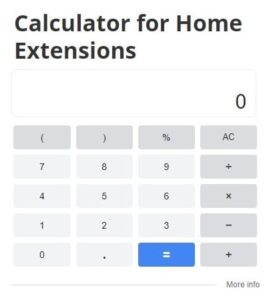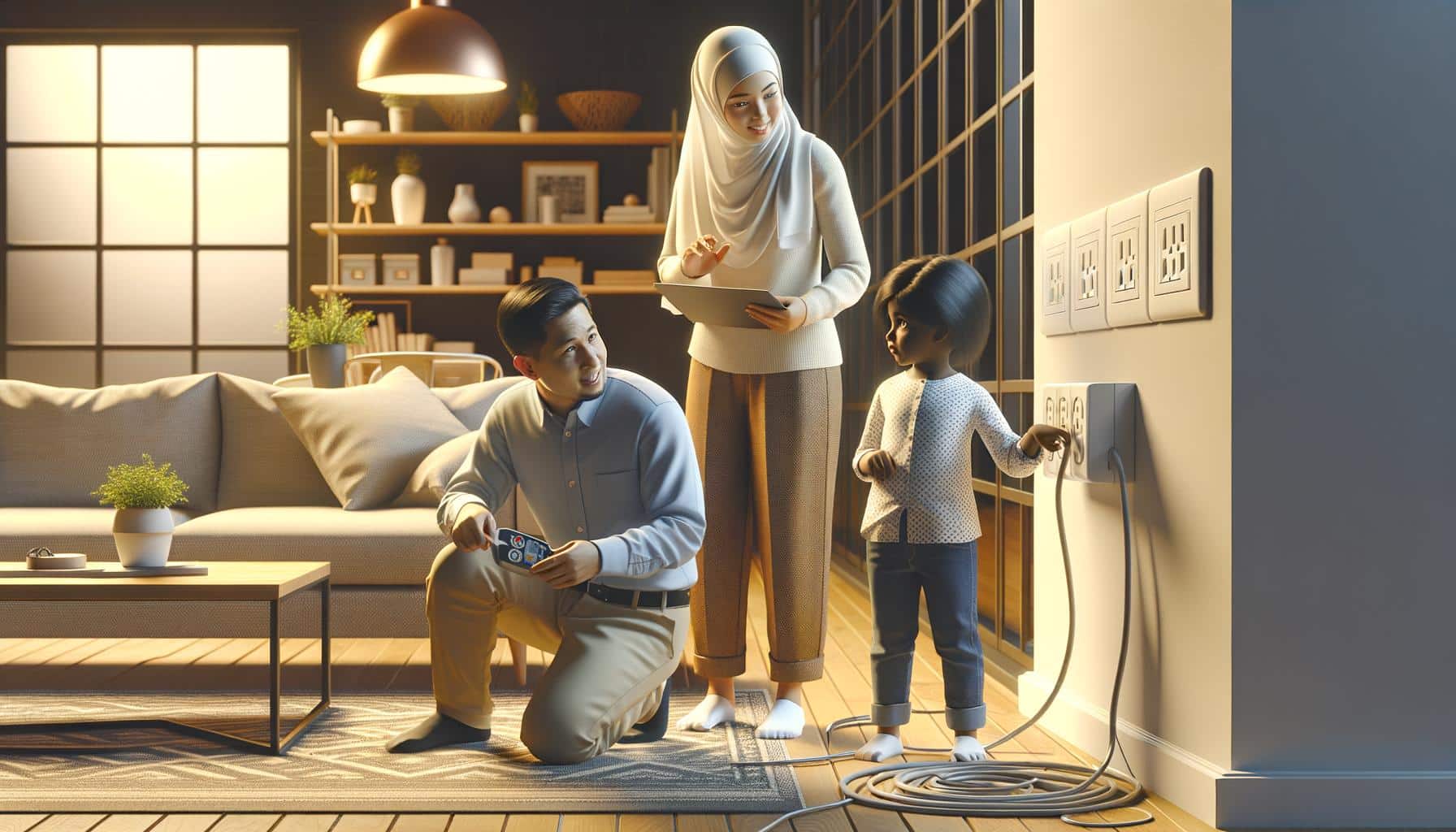
At Home Owners Association, we understand the importance of electrical safety in Australian homes. Protecting your family and property from electrical hazards is a top priority.
This guide will walk you through the do’s and don’ts of electrical safety at home, covering common risks and essential practices. We’ll also clarify what electrical work you can legally perform yourself and when it’s necessary to call in a professional.
Hidden Dangers in Your Home’s Electrical System
Australian homes are filled with modern conveniences, but they also harbor potential electrical hazards that can put your family at risk. Let’s explore some of the most common electrical hazards lurking in Australian homes and what you can do to address them.
The Power Board Predicament
One of the most prevalent issues is the overuse of power boards and extension cords. While these devices offer convenience, they’re not designed for permanent use. Daisy-chaining multiple power boards or using them to power high-wattage appliances can lead to overheating and potentially start a fire. Try to limit the use of power boards and never exceed their rated capacity.
Wiring Woes
Faulty or outdated wiring is another significant concern, especially in older Australian homes. The Electrical Safety Office reports that many fires are caused by old wiring that is worn out or is unable to cope with the demands of modern electrical equipment. Signs of trouble include flickering lights, buzzing sounds from outlets, or frequent circuit breaker trips. If your home is more than 40 years old, it’s important to have a licensed electrician perform a thorough inspection.
Exposed and Dangerous
Exposed electrical components pose a serious risk of electric shock and fire. This includes damaged outlet covers, frayed cords, or improperly installed fixtures. Cases where DIY enthusiasts have left junction boxes open or failed to secure wiring properly are not uncommon. Always ensure that all electrical connections are enclosed and replace damaged cords immediately.
Water and Electricity: A Lethal Combination
The proximity of water to electrical sources is a hazard that’s often overlooked. In bathrooms and kitchens (where water is prevalent), the risk of electrocution increases significantly. The Australian Building Codes Board mandated that safety switches (RCDs) become mandatory protection for all power point circuits in new houses after June 2014. Homeowners should retrofit their homes with safety switches and keep electrical devices away from water sources.
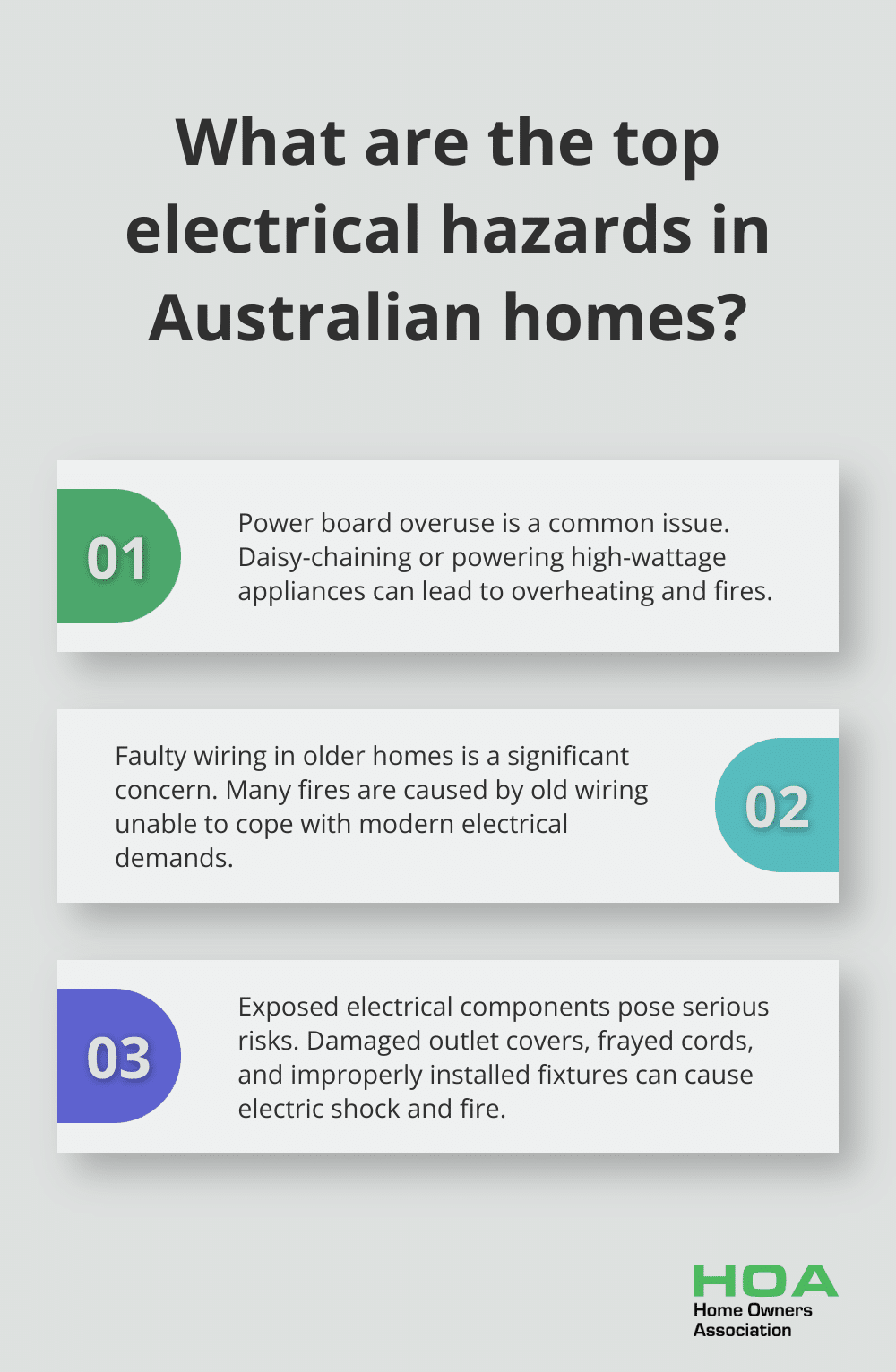
Being aware of these common hazards and taking proactive steps to address them can significantly reduce the risk of electrical accidents in your home. When in doubt, it’s always best to consult with a licensed electrician (safety should never be compromised). Now, let’s move on to essential electrical safety practices that every Australian homeowner should implement to protect their family and property.
How to Safeguard Your Home’s Electrical System
Regular Inspections: Your First Line of Defense
The Electrical Safety Office recommends that you schedule a thorough check of your electrical system every 5-10 years (depending on your home’s age) with a licensed electrician. These professional inspections identify potential issues before they become serious hazards.
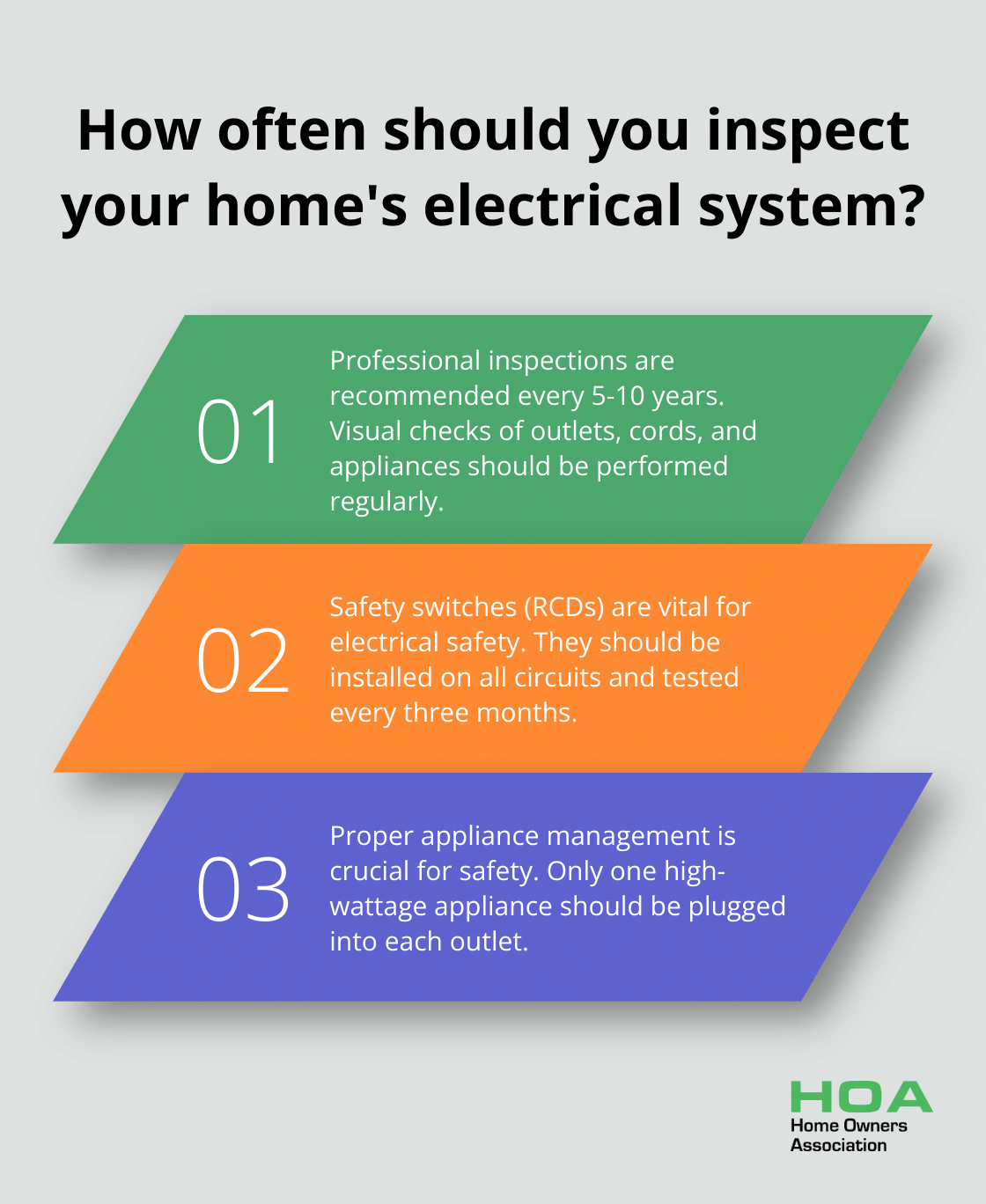
You should perform visual checks of your electrical outlets, cords, and appliances between professional inspections. Look for signs of wear, fraying, or discoloration. Address any issues you notice immediately to prevent accidents.
Harnessing the Power of Safety Switches
Safety switches (also known as Residual Current Devices or RCDs) are vital components of a safe electrical system. These devices detect current leakage and cut off power within milliseconds, which can potentially save lives. They can also provide some protection against electrical fires. Australian Electrical Standards require RCDs on all power and lighting circuits in new homes.
You should consider retrofitting older homes with RCDs as a wise investment. We advise you to install them on all circuits, not just those required by law. Test your RCDs every three months by pressing the test button – if they don’t trip, call an electrician immediately.
Smart Appliance Management
Proper use and storage of electrical appliances play a significant role in home safety. Always follow manufacturer instructions and avoid overloading circuits. A good rule of thumb: plug only one high-wattage appliance into each outlet.
Store appliances in dry areas away from water sources. For items used near water (such as hair dryers), consider purchasing models with built-in GFCIs for added protection. Regularly inspect appliance cords for damage and replace them if necessary.
Creating a Safety-Conscious Household
Educate all family members about electrical safety. Teach children about the dangers of electricity and establish clear rules, such as never inserting objects into outlets or using electrical devices near water.
Provide guidance for adults on recognizing potential hazards and responding to electrical emergencies. Create an easily accessible list of emergency contacts, including your local electrician and energy provider.
These practices will significantly reduce the risk of electrical accidents in your home. However, complex electrical issues require professional expertise. In the next section, we’ll explore what electrical work you can legally perform yourself and when it’s necessary to call in a licensed electrician.
DIY Electrical Work in Australia: What You Can and Can’t Do
Legal Requirements for Electrical Work
Australian law strictly regulates electrical work for safety reasons. Most electrical tasks must be performed by a licensed electrician. This includes any work involving fixed wiring, such as installing new power points, light fittings, or circuit breakers. The penalties for unauthorized electrical work are severe, with fines up to $400,000 for individuals in some states.
Safe Tasks for Homeowners
While the list of permissible DIY electrical tasks is limited, homeowners can safely perform a few tasks:
- Change light bulbs
- Replace plug tops on appliances
- Reset a tripped safety switch or circuit breaker
- Conduct visual inspections of cords and outlets
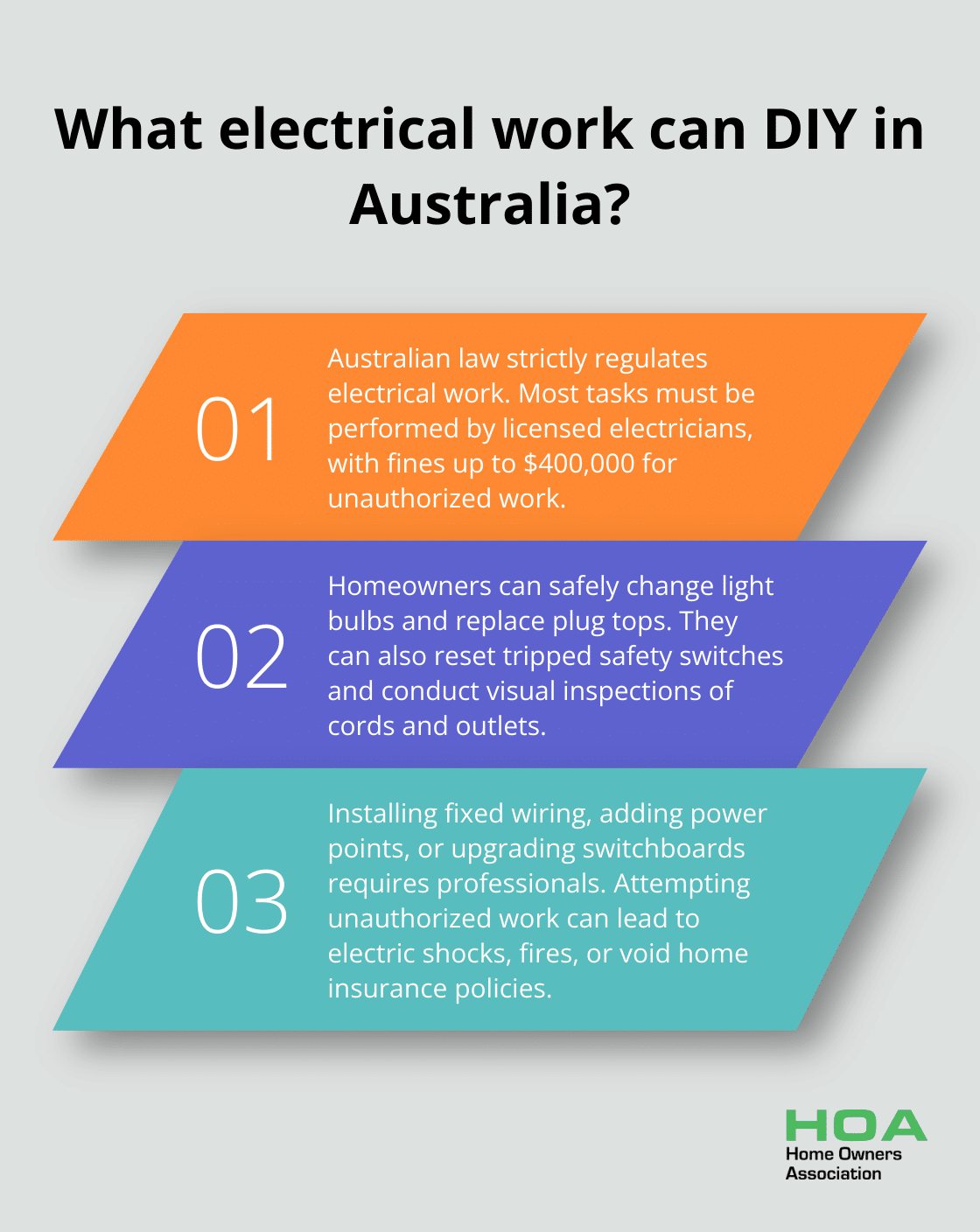
These tasks are considered safe for homeowners to perform, provided they follow proper safety procedures and use the correct tools.
When to Call a Professional
Any task beyond the simple ones listed above requires a licensed electrician. This includes:
- Install or repair any fixed wiring
- Add new power points or light fixtures
- Upgrade your switchboard
- Install safety switches
- Repair electrical appliances
We strongly advise our readers to exercise caution. If you’re unsure whether a task requires a professional, it’s best to consult with a licensed electrician.
Risks of Unauthorized Electrical Work
Attempting electrical work without proper qualifications isn’t just illegal-it’s extremely dangerous. Faulty wiring can lead to electric shocks, fires, or even electrocution. Tree contact, animal contact, other asset failures, and connection faults are among the most common causes of network-related fires.
Moreover, unauthorized electrical work can void your home insurance policy (leaving you financially vulnerable in case of an accident). The potential consequences far outweigh any perceived cost savings.
Finding a Qualified Electrician
When you need electrical work done, it’s important to hire a licensed and insured professional. Try to get recommendations from friends or family, or use reputable online directories. Always ask for proof of licensing and insurance before hiring an electrician.
A qualified electrician will ensure that all work complies with Australian standards and regulations (which is essential for both safety and legal compliance). They can also provide valuable advice on energy efficiency and potential upgrades to your electrical system.
Final Thoughts
Electrical safety at home requires constant attention to protect your family and property. The do’s and don’ts of electrical safety at home include regular inspections, proper use of safety switches, and smart appliance management. You should recognize the limitations of DIY electrical work and consult a licensed electrician for complex tasks.
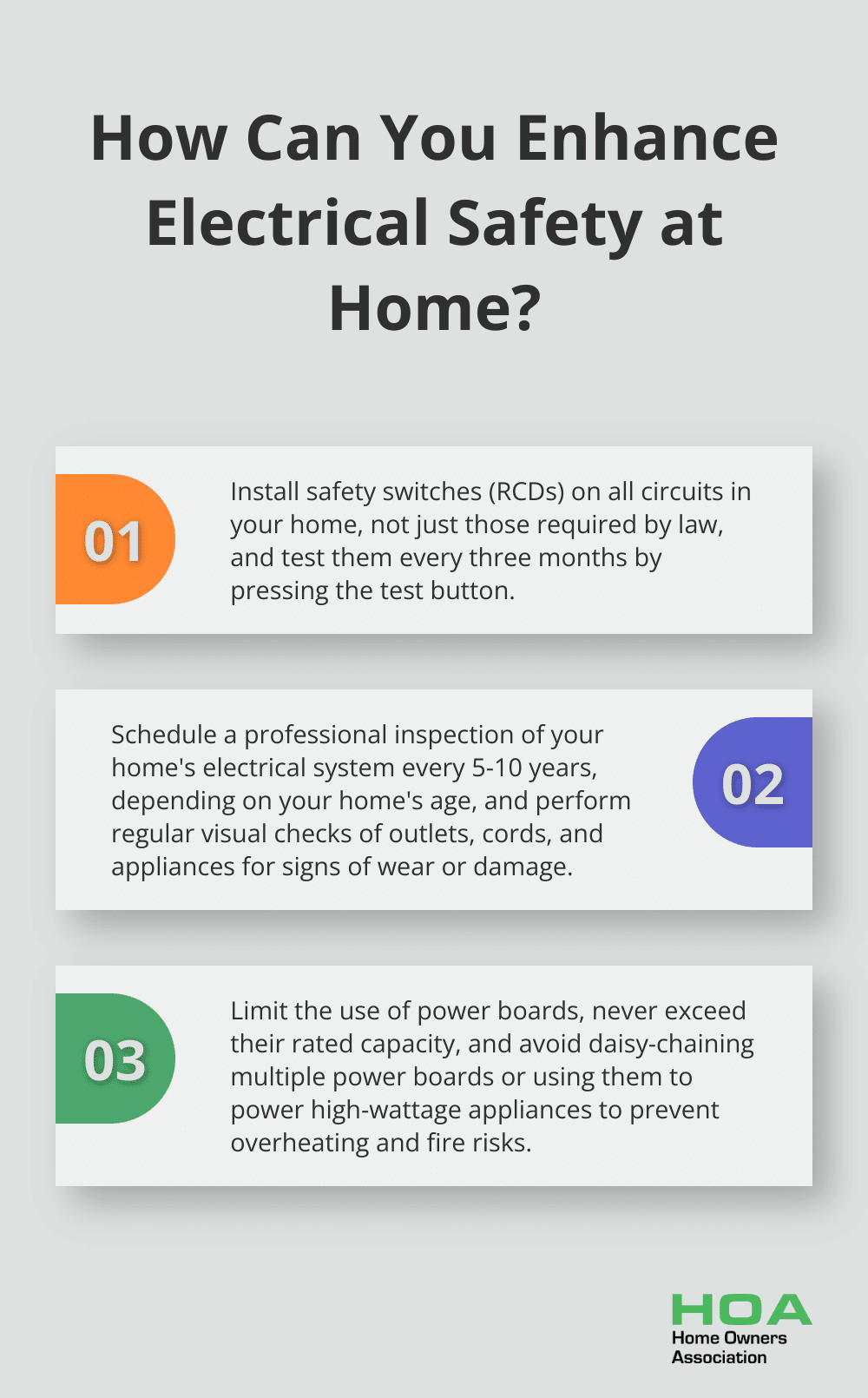
We at Home Owners Association support Melbourne homeowners in all aspects of home maintenance and improvement. Our members receive expert advice, trade discounts, and resources to make informed decisions about their homes. You invest in the long-term security and well-being of your household when you prioritize electrical safety.
Electrical safety is an ongoing process that demands continuous updates as your home’s needs change. You should stay informed about the latest safety standards and technologies to protect your home against electrical hazards. Don’t hesitate to seek professional assistance for a safer, more secure home.





